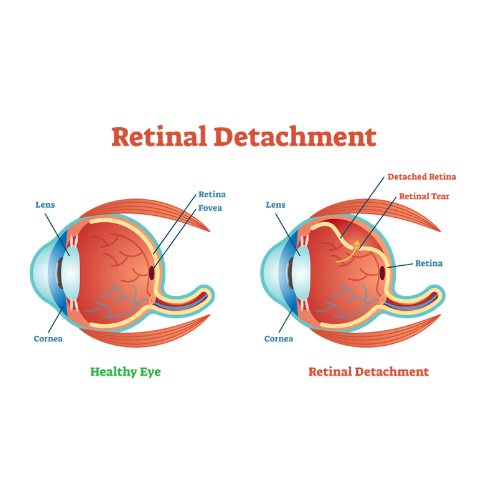Surgery for Retinal Detachment


Retinal detachments are potentially blinding and require various types of retinal detachment surgery. Retina specialists are specifically trained to repair retinal detachments.
Retinal detachment is a medical emergency. If you have symptoms of a detached retina, go to the ER or your eye doctor immediately.
The retina lines the inside of the eye and converts light into electrical signals that it transmits to the brain through the optic nerve. The retina must be anatomically attached to properly transmit signals to the optic nerve.
All retinal tears and holes occur in the peripheral (side) retina, so the loss of side or peripheral vision happens first. If the detachment is not repaired it grows and the macula (central retina) will detach. When the macula has detached there can be permanent vision loss despite successful reattachment. That is why the condition is an emergency.
Symptoms:
- Flashes of light
- Lots of new floaters (small black specks or threads) in your vision.
- A shadow or “curtain” coming across the side of your eye blocking out vision
These symptoms can occur gradually as the retina slowly detaches from the membrane layer of blood vessels that provide it with oxygen and nutrients and that send signals to the optic nerve, or it can happen suddenly if the retina detaches immediately.
Causes
Rhegmatogenous retinal detachments are caused by a hole or tear in the retina that allows fluid to collect under the retina, causing it to detach from its underlying membrane. The rods and cones can not function normally in areas where the retina is detached.
The most common cause of a retinal tear (leading to a retinal detachment) is a posterior vitreous detachment (PVD). As we age the gel-like material (vitreous humor) that fills the inside of the eye may change in consistency. This shrinking causes the vitreous to separate away from the surface of the retina and may pull on the retina with enough force to cause a tear or rupture. Vitreous liquid can also pass through the tear and cause the retina to detach.
Tractional retinal detachments occur when scar tissue grows on the retina’s surface and causes the retina to pull away from the membrane below it. This type of retinal detachment is typically seen in people with poorly controlled diabetes.
Exudative retinal detachments are caused by fluid accumulating beneath the retina. This type of retinal detachment is caused by eye injuries, tumors, inflammatory disorders, and wet macular degeneration.
Treatment for Retinal Detachment
A detached retina requires surgery to return the retina to its proper position where it can be nourished and reconnected to the optic nerve pathway. The following are three common types of procedures or surgeries to reattach retinas:
Vitrectomy for Retinal Detachment
The surgeon removes the vitreous humor from your eye and replaces it with air, gas, or a silicone oil bubble. The bubble pushes the retina pack into place. Vitrectomies can address several eye conditions, but when used for retinal detachment it is usually for tractional retinal detachment repair.
Pneumatic Retinopexy
The surgeon puts a gas bubble inside your eye to push the retina into place. After the procedure you must keep your head in the specific position recommended by your surgeon. Doing so keeps the bubble in the right place. Your body will produce fluid to fill the eye and this fluid will replace the gas bubble.
Scleral Buckling
Sometimes before this procedure the surgeon may use a cryogenic (freezing) tool or a laser to make microscopic scars around any retinal tears you may have to seal them. Then the surgeon places a band of silicon around the outside of the eye to compress the eye, support the retina, and lessen the force caused by the vitreous tugging on the retina.
Retina specialists may also choose to combine the techniques and surgical methods outlined above.
Outcomes
About 90% of retinal detachment repairs are successful. If the detachment has not reached the macular (central retina) vision can usually be restored. If the detachment has reached the macula (central retina) a successful reattachment can improve vision, but you may not regain good enough fine-detail vision in that eye to read.
